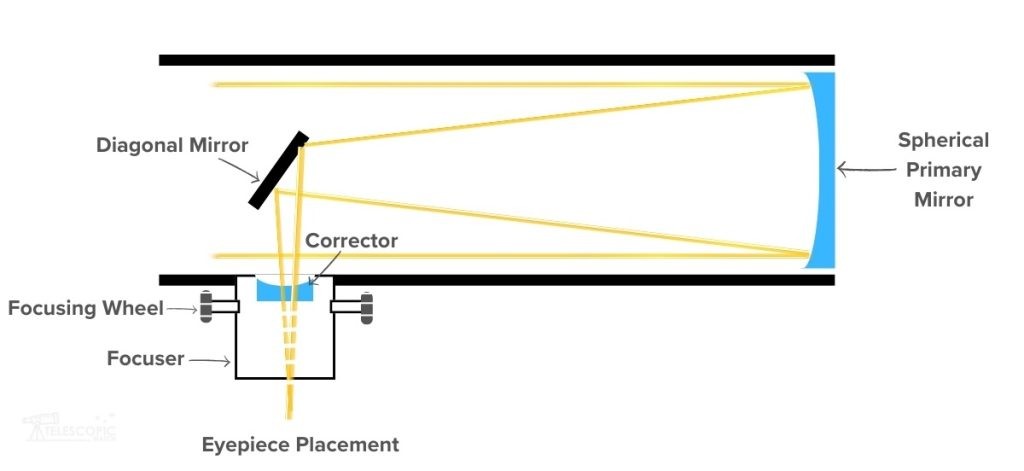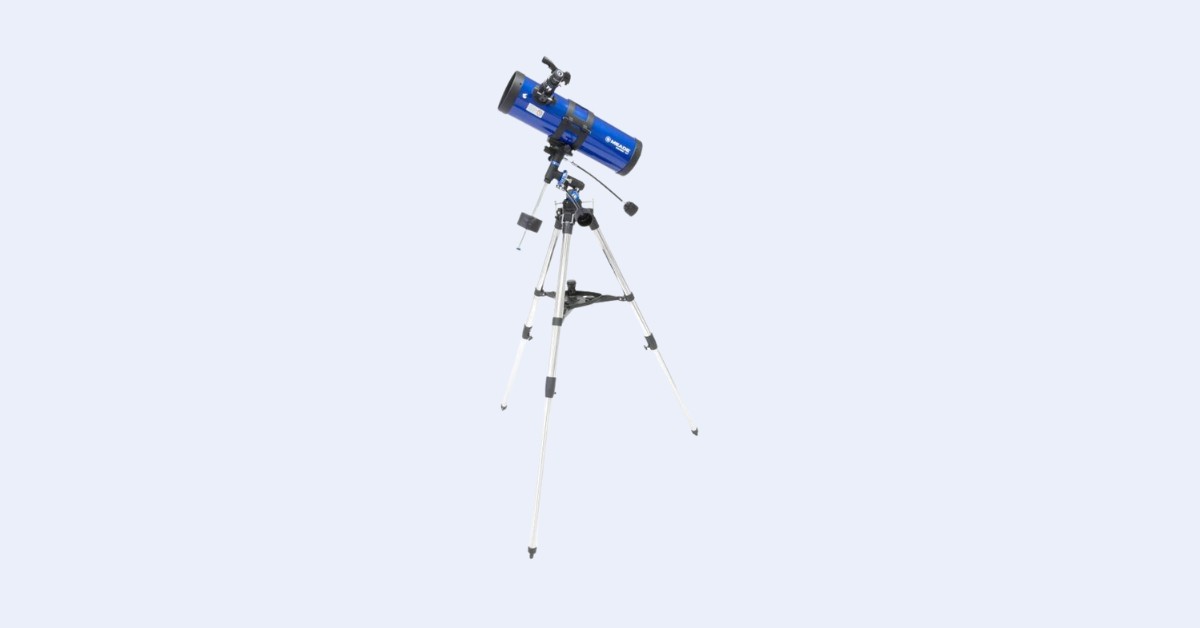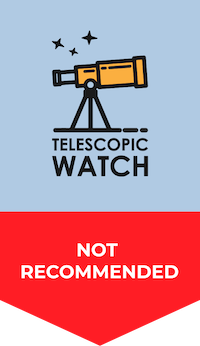The Optical Tube Performance
The Meade Polaris 127 claims to be a 127 mm (5″) f/7.9 Newtonian reflector, sporting a focal length of 1,000 mm. However, this claim immediately raised my eyebrows, as the optical tube of the telescope appears to be far too compact to accommodate a 1000mm focal length.
The Bird-Jones Design and Its Issues
The mystery unfolded when I learned that the Polaris 127 isn’t truly a Newtonian. Of the Bird-Jones optical design, it employs the same optics as the infamous Celestron PowerSeeker 127EQ and numerous other telescopes with the same compromised specifications.
At the time the Bird-Jones design was first conceived, eyepieces were basic and coma correctors were nonexistent. So then, long focal ratios were essential for telescopes to provide sharp images, and the Bird-Jones design achieved this by still using a simple-to-make spherical primary mirror while also keeping the tube fairly stubby and compact. The key component is the corrector lens, which in the original Bird-Jones design is supposed to be placed just before the light from the primary mirror hits the secondary mirror. This corrector lens fixes the spherical aberration that would otherwise be caused by the spherical primary mirror.
The Bird-Jones design was never much of a hit among amateur astronomers. It is now antiquated and no longer necessary, thanks to improvements in eyepiece design and optical manufacturing.

Moreover, in the Polaris 127’s attempt to use the Bird-Jones configuration, the corrector lens is situated within the telescope’s plastic 1.25″ rack-and-pinion focuser, as shown above. This creates issues when I’m trying to collimate the scope accurately. It also means that the spacing of the corrector from other optical components changes when I adjust focus.
I’ve also noticed that the corrector lens itself is extremely low-quality and so, it wouldn’t allow the Polaris 127 to achieve sharp images even with other constraining factors absent.
Collimating a Bird-Jones Like Polaris 127
Precisely collimating a typical mass-produced Bird-Jones telescope like the Polaris 127 involves disassembling the focuser with a screwdriver and carefully unscrewing a plastic retention ring to extract the corrector before collimating as with a standard Newtonian.
We then meticulously need to re-insert the corrector without contaminating it with focuser grease or fingerprints. Furthermore, it’s important to ensure the corrector is reinserted in the right orientation. Obviously, this is extremely difficult to do in the field, let alone if you have never collimated a telescope before or are attempting to do so in the dark.
Collimating the telescope on a star is an alternative method for making minor adjustments and won’t require disassembly of the Polaris 127’s focuser, but it requires practice. Our collimation guide provides more information.
The Polaris 127 and similar 127mm Bird-Jones scopes are even worse than the 114mm Bird-Jones scopes like the Polaris 114 optically due to the lower collimation tolerances with the increased aperture as well as even worse quality control.
Decent Set of Accessories
The three eyepieces supplied with the Meade Polaris telescopes are plastic-bodied 1.25″ Meade MA 3-element eyepieces. Those included with the Polaris 127 are a 26 mm (39x), a 9mm (111x), and a 6.3 mm (159x), any of which can be used with the provided 2x Barlow to double their respective magnifications to 78x, 222x, and 318x.
The 2x Barlow lens included with the Polaris telescopes is predominantly plastic in construction, like the eyepieces. While it performs surprisingly well, I’d advise to replace it with a superior unit or refrain from using it entirely if possible.
The included 6.3mm MA eyepiece offers extremely limited eye relief, making it necessary to press my eye uncomfortably close to it in order to see anything. Furthermore, the 159x magnification the 6.3mm eyepiece provides exceeds the capabilities of the Polaris 127’s flawed optics, even more when used with the 2x Barlow lens for a staggering 318x, a magnification a bit beyond what any telescope of this aperture can be expected to provide sharp images at, even if it had good optics, which is hardly the case here.
The Polaris 127 also includes a simple red-dot finder, which falls short of the quality that I typically found in Celestron and Sky-Watcher models. Although it functions adequately and is a step up from low-quality 5×24 or 6×30 finders, adjusting it proves challenging. The on/off switch is minuscule, and the plastic window used to view the projected red dot is also slightly tinted, reducing the brightness of the sky. While it may suffice, and replacing it may not be cost-effective in any case, it is far from well-made.
The Polaris EQ2 Mount
The EQ2 equatorial mount included with the Meade Polaris telescopes is a standard, cheaply made German equatorial similar in design, construction, and weight capacity to the one supplied with the Celestron AstroMaster telescopes.
While not the most well-made, with no provision for a polar scope and plenty of plastic castings holding it together, the Polaris EQ2 is alright, though it’s a bit undersized for a 127mm optical tube. If the tube were any heavier, it would have been completely unusable, even at fairly low power.
What I’d do to preserve the Polaris 127’s stability is avoid full extension of the EQ2’s tripod legs, fill the legs with foam or sand, and place a heavy item, such as weights or a water jug, on the accessory tray to lower the telescope’s center of gravity.
As is par for the course, the EQ2 is also provided with flexible slow-motion cables for both axes and fine adjustments in altitude, as well as azimuth for precise polar alignment.
The mount can also be fitted with a motor drive, such as the Celestron Logic Drive, to enable hands-free tracking.
The Polaris EQ2 mount is equipped with a Vixen-style dovetail saddle, allowing for interchangeable use of other optical tubes without needing tools
The Polaris 127 optical tube connects to its supplied EQ2 mount using a set of tube rings, which enable the tube to rotate and slide back and forth for balance on the declination axis and convenient positioning of the eyepiece and finder. It is worth noting that German equatorial mounts can sometimes position the eyepiece of a Newtonian telescope inconveniently, necessitating rotation of the tube in its rings for a more comfortable viewing angle.
Should I buy a Used Meade Polaris 127?
Considering the Meade Polaris 127’s extremely poor optics and other lackluster features, a used unit is still not worth buying. Regardless, the standard precautions of inspecting the mirror coatings, tripod, and accessories for damage apply.
Alternative Recommendations
The Meade Polaris 127’s horrible optics and otherwise mediocre features mean we’d highly recommend picking something from our top picks below or otherwise off our recommended telescope rankings.
Under $350
- The Zhumell Z114 doesn’t have as much aperture as the Polaris 127, but it’s on a more stable mount, features a sharp parabolic primary mirror, and is a lot easier to use.
- The Sky-Watcher Heritage 130P offers a similar aperture to the Polaris 127 but features a truly parabolic primary mirror, high-quality included eyepieces, and a much wider potential field of view due to its shorter focal length. The scope collapses to fit into a backpack and is easy to assemble, aim, and operate.
- The Sky-Watcher Heritage 150P boasts a large 150mm (6″) primary mirror, as well as the same collapsible tube, Dobsonian mount, and top-quality accessories as the smaller Heritage 130P.
$350-$550
- The Sky-Watcher Virtuoso GTi 150P Tabletop Dobsonian has the same optics, features and accessories as the Heritage 150P, but adds motorized tracking/GoTo with smartphone operation and FreedomFind encoders to the mix, along with a ⅜” stud for mounting to a tripod. The GTi 130P is identical in its upgrades but features the Heritage 130P optical tube instead.
- The Apertura AD6 offers a far superior experience to the Polaris 127 with a robust Dobsonian mount that eliminates the need for a table or tripod, a large 6″ primary mirror, and a high-quality 2″ Crayford focuser.
Aftermarket Accessories Recommendations
A 15mm focal length redline or goldline eyepiece (67x) could be useful with the Meade Polaris 127, but may not be worth the investment given the telescope’s limited capabilities. More useful is a Celestron Logic Drive, which enables the Polaris EQ-2 mount to track the sky automatically, liberating you from making constant manual adjustments on the right ascension axis, which can easily induce vibrations.
Furthermore, a UHC nebula filter, although a costly investment for the Polaris 127, can enhance your views of bright nebulae such as Orion (M42), the Swan (M17), or the Lagoon (M8) by attaching to a low-power eyepiece like the provided 26mm MA. While it is not a universal solution for light pollution and only works on nebulae, a UHC is an excellent addition to your toolkit. It will also be compatible with other, superior telescopes you may acquire in the future.
What can you see?
The Meade Polaris 127’s poor optics are better tolerated when it comes to low-power views, i.e., those of deep-sky objects. Light pollution is the main constraint when observing deep-sky objects, but not all targets are affected equally.
- Open star clusters, for instance, can look stunning from almost any location due to their brightness, and the Polaris 127 will showcase hundreds of vibrant stars in bright clusters like M35, M45 (the Pleiades), M11, or the Double Cluster.
- Unfortunately, the inferior optics of the Polaris 127 are likely to hinder the resolution of globular star clusters; a good 114mm-130mm reflector like the Zhumell 114 or Heritage 130P has no trouble resolving individual stars but the Polaris 127 will just show you fuzzy blobs.
- While many galaxies are too faint and small to reveal details with the Polaris 127 or even a good telescope of this size, galaxies with prominent dust lanes, such as M82 or M65, might display these high-contrast features under dark or semi-dark skies with patience.
- Bright emission nebulae like the Orion Nebula (M42) or the Swan Nebula (M17) present wispy details that can be best observed under dark skies or with a UHC narrowband nebula filter.
With adequate collimation, the Polaris 127 can offer relatively enjoyable views of the solar system objects.
- Observing the phases of Venus is possible, while discerning those of Mercury may prove more difficult.
- Mars’ surface may reveal a dark spot or two, along with one of the planet’s polar ice caps, when it is near Earth.
- Jupiter’s moons and cloud belts are easily resolvable, although the polar zones and the Great Red Spot may remain elusive. The moons should readily appear as disks at this aperture, but the Polaris 127’s subpar optics will blur them too much, along with their shadows during transits.
- Saturn’s rings and a few moons can be detected.
- Uranus and Neptune will appear as fuzzy, star-like points, assuming you can locate them in the first place.
Astrophotography
The low quality of the Meade Polaris 127’s optics makes capturing decent images of the night sky an unachievable goal. Moreover, attaching a camera, whether directly or piggybacked, would upset the balance and place undue stress on the EQ2 mount.




I have a Meade Polaris 130 given as a gift. We have decided to sell. Rarely used. Could you give a suggestion on a fair price for this model. Can’t find it on line. Maybe discontinued.
Thank you.